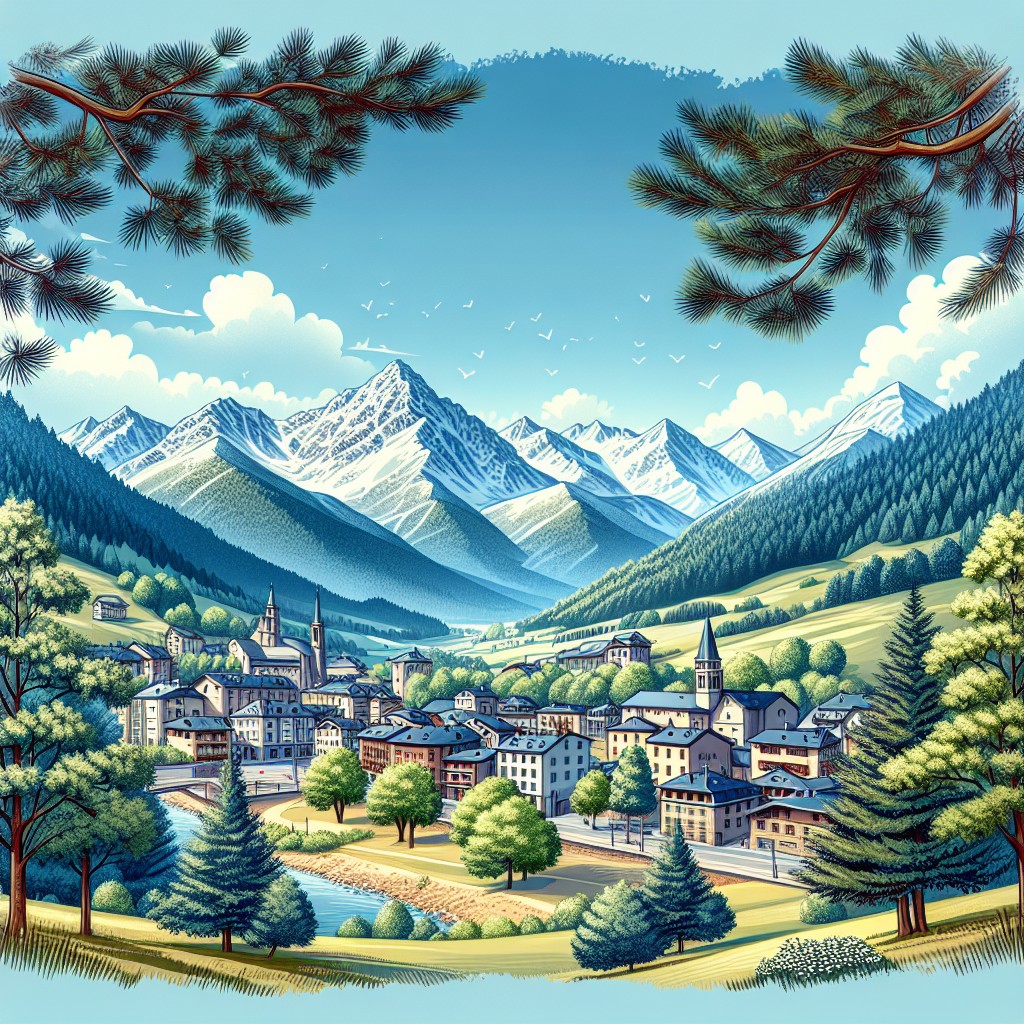Andorra, a small landlocked country nestled in the Pyrenees Mountains between France and Spain, is known for its stunning natural beauty. However, what many people may not realize is that Andorra also has a rich cultural heritage that dates back centuries. From its unique location and history to its ancient churches and chapels, magnificent castles and fortresses, and fascinating museums, Andorra offers a wealth of cultural experiences for visitors to explore. In this article, we will take a journey through Andorra’s rich cultural heritage, uncovering the history behind its landmarks, exploring its iconic cultural sites, and delving into the significance of its art and architecture. Join us as we discover the hidden gems of Andorra’s cultural heritage.
Summary
- Andorra has a rich cultural heritage that is worth exploring.
- The country’s landmarks have fascinating histories that are worth uncovering.
- Andorra’s iconic cultural sites are a must-visit for anyone interested in the country’s culture.
- The ancient churches and chapels of Andorra are a testament to the country’s religious history.
- Andorra’s castles and fortresses are magnificent structures that are worth exploring.
Discovering the Rich Cultural Heritage of Andorra
Andorra’s unique location and history have played a significant role in shaping its cultural heritage. Situated between France and Spain, Andorra has been influenced by both Catalan and French cultures. The Catalan influence is particularly strong, as Catalan is the official language of Andorra and Catalan traditions are deeply ingrained in the country’s customs and celebrations. This blend of cultures has created a unique identity for Andorra, one that is reflected in its art, architecture, cuisine, and festivals.
Preserving Andorra’s cultural heritage is of utmost importance to the country. The government has implemented various measures to protect and promote its cultural assets, including the establishment of museums, the restoration of historical sites, and the preservation of traditional crafts. By preserving its cultural heritage, Andorra aims to maintain its identity and provide visitors with a glimpse into its rich history.
Uncovering the Fascinating History of Andorra’s Landmarks
Andorra is home to several landmarks that have played a significant role in shaping the country’s history. One such landmark is Casa de la Vall, the historic parliament building located in the capital city of Andorra la Vella. Built in the 16th century, Casa de la Vall served as the seat of government for centuries and is now a symbol of Andorra’s political autonomy. Another notable landmark is Sant Joan de Caselles, a Romanesque church located in the village of Canillo. Dating back to the 11th century, this church is known for its beautiful frescoes and intricate stone carvings.
Each landmark in Andorra has its own unique significance. For example, the Pont de la Margineda, a medieval bridge located near Andorra la Vella, played a crucial role in connecting Andorra to the outside world and facilitating trade. The Church of Santa Coloma, one of the oldest churches in Andorra, is known for its distinctive Lombard Romanesque architecture and is considered a masterpiece of medieval art.
A Journey Through Andorra’s Most Iconic Cultural Sites
Andorra is home to several iconic cultural sites that are must-visit destinations for anyone interested in exploring the country’s rich heritage. One such site is the Vallnord ski resort, which not only offers world-class skiing and snowboarding but also hosts cultural events throughout the year. Another iconic site is the Caldea spa complex, which combines relaxation with cultural experiences such as art exhibitions and live performances.
For those interested in history, a visit to the Casa Rull museum is a must. Housed in a traditional Andorran house dating back to the 17th century, this museum provides visitors with a glimpse into daily life in Andorra during that time period. The National Automobile Museum is another popular cultural site, showcasing a collection of vintage cars and motorcycles that tell the story of transportation throughout history.
Exploring the Ancient Churches and Chapels of Andorra
Andorra is home to numerous ancient churches and chapels that are not only architectural marvels but also important religious sites. These religious buildings provide a glimpse into the country’s spiritual history and the role of religion in shaping its cultural heritage.
One such church is the Church of Sant Esteve, located in the heart of Andorra la Vella. Dating back to the 11th century, this Romanesque church is known for its beautiful frescoes and ornate altarpiece. Another notable church is the Church of Sant Joan de Caselles, mentioned earlier, which is known for its stunning Romanesque architecture and intricate stone carvings.
The Magnificent Castles and Fortresses of Andorra
Andorra is home to several magnificent castles and fortresses that have played a crucial role in the country’s history. These structures not only provide a glimpse into Andorra’s past but also contribute to its cultural heritage.
One such castle is the Castle of Sant Vicenç d’Enclar, located on a hilltop overlooking Andorra la Vella. Dating back to the 9th century, this castle offers panoramic views of the surrounding landscape and provides visitors with a sense of the country’s medieval history. Another notable fortress is the Castle of Llívia, located in the town of Llívia. Built in the 13th century, this fortress served as a strategic defense point and is now a popular tourist attraction.
The Fascinating Museums of Andorra: A Glimpse into the Past
Andorra is home to several fascinating museums that offer a glimpse into the country’s past and preserve its cultural heritage. These museums house a wide range of artifacts and exhibits that tell the story of Andorra’s history, art, and traditions.
One such museum is the Museum Casa Cristo, located in Encamp. Housed in a traditional Andorran house, this museum showcases a collection of traditional crafts and tools that were used by Andorran artisans throughout history. Another notable museum is the Postal Museum, located in Ordino. This museum tells the story of Andorra’s postal service and its role in connecting the country to the outside world.
The Importance of Andorra’s Romanesque Art and Architecture
Romanesque art and architecture have played a significant role in shaping Andorra’s cultural heritage. This style, characterized by its rounded arches, thick walls, and decorative carvings, can be seen in many of Andorra’s churches, chapels, and castles.
One example of Romanesque art and architecture in Andorra is the Church of Santa Coloma. This church, dating back to the 9th century, is known for its Lombard Romanesque architecture and is considered a masterpiece of medieval art. Another example is the Church of Sant Joan de Caselles, mentioned earlier, which features intricate stone carvings and beautiful frescoes.
The Natural Wonders of Andorra: A Blend of Culture and Scenery
Andorra’s natural wonders not only offer breathtaking scenery but also have cultural significance. These natural wonders, such as the Madriu-Perafita-Claror Valley and the Coma Pedrosa Natural Park, are protected areas that showcase Andorra’s unique biodiversity and provide a habitat for various plant and animal species.
The Madriu-Perafita-Claror Valley, a UNESCO World Heritage site, is not only a stunning landscape but also an important cultural site. This valley has been inhabited since prehistoric times and is home to several traditional Andorran houses and agricultural terraces. The Coma Pedrosa Natural Park, on the other hand, offers hiking trails that allow visitors to explore Andorra’s natural beauty while learning about its flora and fauna.
Andorra’s Historic Towns and Villages: A Step Back in Time
Andorra is home to several historic towns and villages that offer a step back in time. These towns and villages not only showcase traditional Andorran architecture but also provide a glimpse into the country’s rural way of life.
One such town is Ordino, located in the northern part of Andorra. Known for its well-preserved medieval architecture, Ordino offers visitors the opportunity to explore narrow streets lined with stone houses and visit the Casa d’Areny-Plandolit, a historic house that has been converted into a museum. Another historic town is Sant Julià de Lòria, located in the southern part of Andorra. This town is known for its Romanesque church and its traditional houses, some of which have been converted into shops and restaurants.
The Legacy of Andorra’s Cultural and Historical Icons: Preserving the Past for Future Generations
Preserving Andorra’s cultural and historical icons is of utmost importance to ensure that future generations can continue to appreciate and learn from them. The government of Andorra has implemented various measures to protect and promote these icons, including the restoration of historical sites, the establishment of museums, and the promotion of traditional crafts.
Tourism also plays a crucial role in preserving Andorra’s cultural heritage. By attracting visitors from around the world, Andorra can generate revenue that can be used to maintain and restore cultural sites, as well as support local artisans and craftsmen. Additionally, tourism provides an opportunity for cultural exchange, allowing visitors to learn about Andorra’s history, traditions, and way of life.
Andorra’s rich cultural heritage is a testament to its unique location, history, and traditions. From its ancient churches and chapels to its magnificent castles and fortresses, from its fascinating museums to its natural wonders, Andorra offers a wealth of cultural experiences for visitors to explore. By preserving its cultural and historical icons, Andorra ensures that future generations can continue to appreciate and learn from its rich heritage. So, why not plan a trip to Andorra and experience its cultural and historical icons firsthand? You won’t be disappointed.
FAQs
What are some important cultural landmarks in Andorra?
Andorra has several important cultural landmarks, including the Casa de la Vall, the National Automobile Museum, the Postal Museum, and the Tobacco Museum.
What is the Casa de la Vall?
The Casa de la Vall is a historic house in Andorra la Vella, the capital of Andorra. It was built in the sixteenth century and served as the seat of the Andorran parliament until 2011. Today, it is a museum and cultural center.
What is the National Automobile Museum?
The National Automobile Museum is a museum in Encamp, Andorra that showcases vintage cars and motorcycles. It has a collection of over 80 vehicles, including cars from the early 20th century and classic racing cars.
What is the Postal Museum?
The Postal Museum is a museum in Ordino, Andorra that showcases the history of the Andorran postal service. It has exhibits on the development of the postal service in Andorra, as well as displays of stamps and other postal memorabilia.
What is the Tobacco Museum?
The Tobacco Museum is a museum in Sant Julià de Lòria, Andorra that showcases the history of tobacco production in Andorra. It has exhibits on the cultivation and processing of tobacco, as well as displays of tobacco-related artifacts and memorabilia.


